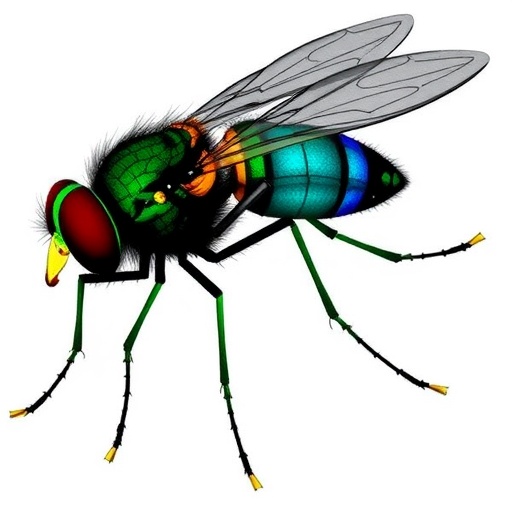In the intricate dance of movement control, feedback from proprioceptive sensory neurons plays an essential role in guiding coordinated actions. These neurons, embedded within muscles and joints, constantly relay information about limb position and motion to the nervous system, enabling precise adjustments during behavior. However, the dynamic regulation of such proprioceptive signals according to different behavioral contexts—such as walking, grooming, or resting—has remained a perplexing mystery for neuroscientists. A groundbreaking study published in Nature in 2025 by Dallmann et al. has now unraveled a neural circuit in Drosophila that dynamically suppresses specific proprioceptive inputs, shedding light on how animals finely tune sensory feedback during self-generated movements.
Proprioception, the sense of self-body position and movement, fundamentally underpins motor control, allowing animals to seamlessly adjust to environmental demands and internal goals. Distinct types of proprioceptive neurons encode different sensorimotor signals: some relay precise limb position information, while others signal limb movement. The brain and spinal cord integrate these divergent streams, enabling smooth and adaptive motor outputs. Nevertheless, the feedback from these neurons is not static; it must be selectively modulated to filter out reafferent signals produced by one’s own movements, preventing confusion or maladaptive reflexes.
The study by Dallmann and colleagues leverages the powerful genetic tools and well-characterized nervous system of the fruit fly, Drosophila melanogaster, to probe proprioceptive feedback regulation at unprecedented resolution. Using targeted calcium imaging techniques in freely behaving flies, the researchers observed the activity of proprioceptive neuron populations encoding either position or movement of the fly’s legs across a range of natural behaviors. Remarkably, while position-encoding neurons remained tonically active during diverse behaviors, the activity of movement-encoding proprioceptors was selectively suppressed during active leg movements such as walking and grooming.
To delineate the circuit mechanisms underlying this selective suppression, the team employed high-resolution connectomics data from recent reconstructions of the Drosophila ventral nerve cord. This approach allowed them to identify a specific class of GABAergic interneurons exerting presynaptic inhibition onto the axons of movement-encoding proprioceptors. Presynaptic inhibition is a potent mechanism that decreases neurotransmitter release from targeted sensory neurons before their signals reach downstream circuitry, effectively gating sensory feedback in a behavior-dependent manner.
Intriguingly, these inhibitory interneurons were found to integrate input from two parallel descending pathways—one excitatory and one inhibitory—originating from the brain. This convergent input enables flexible control over the interneurons’ activity, facilitating context-specific modulation of proprioceptive feedback tailored to each leg. Such neural architecture suggests a sophisticated command hierarchy whereby the brain can selectively silence redundant or irrelevant sensory signals during movement execution, thereby sharpening the precision of sensorimotor integration.
Further functional imaging of the identified inhibitory interneurons and their descending inputs provided compelling evidence linking their activation to self-initiated limb movements rather than passive motion. This distinction underscores the adaptive nature of the observed presynaptic inhibition: it prevents the nervous system from responding to feedback generated by the animal’s own movements, which could otherwise lead to destabilizing reflexes or sensory overload.
The selective silencing of movement-sensitive proprioceptive signals during active behavior revealed in this study points to a fundamental principle of sensorimotor control. By filtering out predictable sensory reafference, the nervous system optimizes its response to unexpected perturbations or external stimuli. This mechanism aligns with longstanding hypotheses in vertebrate motor control and adds a powerful example from invertebrate neuroscience, illustrating evolutionary convergence in sensory feedback modulation strategies.
Notably, the use of Drosophila as a model system highlights how cutting-edge connectomics combined with in vivo functional imaging can dissect complex sensorimotor circuits with molecular and cellular specificity. This integrative methodology paves the way for future exploration of how higher-order brain centers coordinate with spinal or ventral nerve cord circuits to orchestrate nuanced behavioral states and motor programs.
The discovery of context-specific presynaptic inhibition also advances our understanding of diseases affecting sensorimotor integration and proprioception. Dysfunctions in similar inhibitory circuits may underlie movement disorders characterized by impaired feedback processing, such as dystonia or certain forms of ataxia, indicating potential translational relevance of these findings.
Moreover, these insights have implications beyond biology, offering inspiration for developing bioinspired robotic systems and neural prosthetics that emulate the selective gating of sensory signals to enhance stability and adaptability during complex movements.
In summary, the work of Dallmann et al. elegantly elucidates a neural mechanism by which selective presynaptic inhibition sculpts proprioceptive feedback in behaving Drosophila. By integrating anatomical, functional, and behavioral analyses, the study reveals how the nervous system dynamically suppresses specific sensory inputs during self-generated leg movements, ensuring precise sensorimotor control. This pioneering research expands our fundamental knowledge of proprioceptive modulation and opens new avenues for investigating how neural circuits achieve flexible feedback control across species.
Subject of Research: Neural circuits underlying proprioceptive feedback modulation during movement in Drosophila melanogaster
Article Title: Selective presynaptic inhibition of leg proprioception in behaving Drosophila
Article References:
Dallmann, C.J., Luo, Y., Agrawal, S. et al. Selective presynaptic inhibition of leg proprioception in behaving Drosophila. Nature (2025). https://doi.org/10.1038/s41586-025-09554-2
Tags: adaptive motor outputsDrosophila proprioceptiondynamic regulation of proprioceptive signalslimb position and motion integrationmotor control and behaviorneural circuits in movement controlneuroscience of proprioceptionproprioceptive sensory neuronsreafferent signal filteringselective presynaptic inhibitionself-generated movement adjustmentssensory feedback modulation





